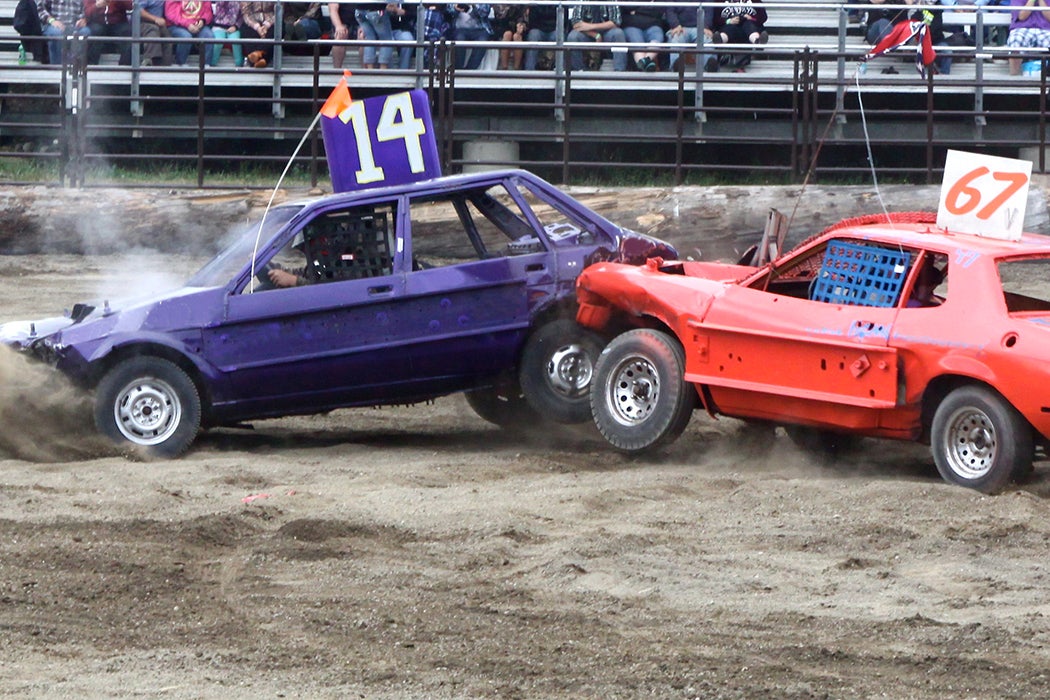Start your motors… and then wreck ’em! Americans have been crashing cars for fun and profit since the 1920s. The demolition derby is generally thought of as a rural, blue-collar phenomenon, but the first big ones blossomed in urban venues like Chicago’s Soldier Field and the New York World’s Fair of 1939.
The automobile may be the defining technology of the twentieth century. It is, according to Itai Vardi, “prized iconic technology…highly revered and celebrated…purporting to provide unfettered accessibility, individual-based expression, and social mobility.” So where, then, “did this need to destroy the mythologized object emanate from and which purposes did it serve?” What’s the cultural logic of the deliberate car crash as entertainment?
Of course, like pro-wrestling and television politics, demolition derbies are staged events, what Vardi calls “a mock practice.” Destructive, yes, but controlled. And, indeed, they stem from a longer tradition of “reenacting technological destruction for public amusement.”
“Wrecking material objects to entertain live crowds” has such precedents as recreating eruptions of Mount Vesuvius at Coney Island in the 1880s. By the early 1900s, Coney Island—the nation’s premier outdoor recreation center—hosted six different disaster shows. The Johnstown Flood and Boer War battles were recreated, but it was the fires that really drew the crowds. These were real conflagrations, staged in replica multi-story buildings, with a cast of “firefighters” in full gear.
In 1896, a publicity-hungry Ohio railroad staged a collision in which two old locomotives pulling dilapidated cars (with dummy passengers visible in the windows) smashed into each other. There were 25,000 people watching. Afterwards, they scrambled to collect souvenirs from the colossal wreck. This was the first of numerous railroad crash spectacles. The phenomenon lost steam after two audience members were killed and scores wounded at one such spectacle in Texas.
In the 1930s, daredevil pilot Frank Frakes specialized in crashing airplanes into trees, pre-fab houses, and sometimes even the ground in front of crowds. Yet simulated fires, railroad duels, and plane smash-ups have all faded as entertainment. Only the deliberate car crash, pioneered in the early 1920s by Ward Beam’s daredevil troupe, has had staying power. The Depression helped, as more people were willing to work as stunt drivers, and more spectators were eager for cheap entertainment.
Thrill Drivers and Death Dodgers worked alongside the growing phenomenon of car racing. Racetrack owners recognized the (unplanned) crash as the biggest draw for an audience. But on top of all this lust for destruction, Vardi argues, was the auto industry’s own turn in the early 1920s to planned obsolescence. This provided the fodder for destruction: last year’s model car. The model year concept marked the change from function to form for automakers and advertisers. “Aesthetic retooling”—more of the consumer than the vehicle—turned out to be very profitable.
Vardi notes, “the policy of frequent model changes thus must be understood as an index of destruction, not only of production.” The consumer needed to be dissatisfied, envious, constantly relegating past novelties to the junk pile. “You’re stupid to go out every year and buy a brand new car,” said a Chrysler designer, which is why makers and sellers had to appeal to emotion and desire.
The industry’s “element of destructibility and disposability became an inherent part of the production process and representation of cars in the public sphere.” Automakers, you won’t be surprise to learn, happily sponsored demolition entrepreneurs and derby venues. The trashing of a car’s symbolic meaning by designers and advertisers preceded the physical crashing of the old heap in a demolition derby.







